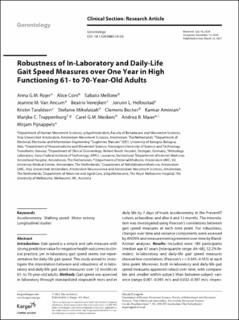| dc.description.abstract | Introduction: Gait speed is a simple and safe measure with strong predictive value for negative health outcomes in clinical practice, yet in-laboratory gait speed seems not representative for daily-life gait speed. This study aimed to investigate the interrelation between and robustness of in-laboratory and daily-life gait speed measures over 12 months in 61- to 70-year-old adults. Methods: Gait speed was assessed in laboratory through standardized stopwatch tests and in daily life by 7 days of trunk accelerometry in the PreventIT cohort, at baseline, and after 6 and 12 months. The interrelation was investigated using Pearson’s correlations between gait speed measures at each time point. For robustness, changes over time and variance components were assessed by ANOVA and measurement agreement over time by Bland-Altman analyses. Results: Included were 189 participants (median age 67 years [interquartile range: 64–68], 52.2% females). In-laboratory and daily-life gait speed measures showed low correlations (Pearson’s r = 0.045–0.455) at each time point. Moreover, both in-laboratory and daily-life gait speed measures appeared robust over time, with comparable and smaller within-subject than between-subject variance (range 0.001–0.095 m/s and 0.032–0.397 m/s, respectively) and minimal differences between measurements over time (Bland-Altman) with wide limits of agreement (standard deviation of mean difference range: 0.12–0.34 m/s). Discussion/Conclusion: In-laboratory and daily-life gait speed measures show robust assessments of gait speed over 12 months and are distinct constructs in this population of high-functioning adults. This suggests that (a combination of) both measures may have added value in predicting health outcomes. | en_US |

